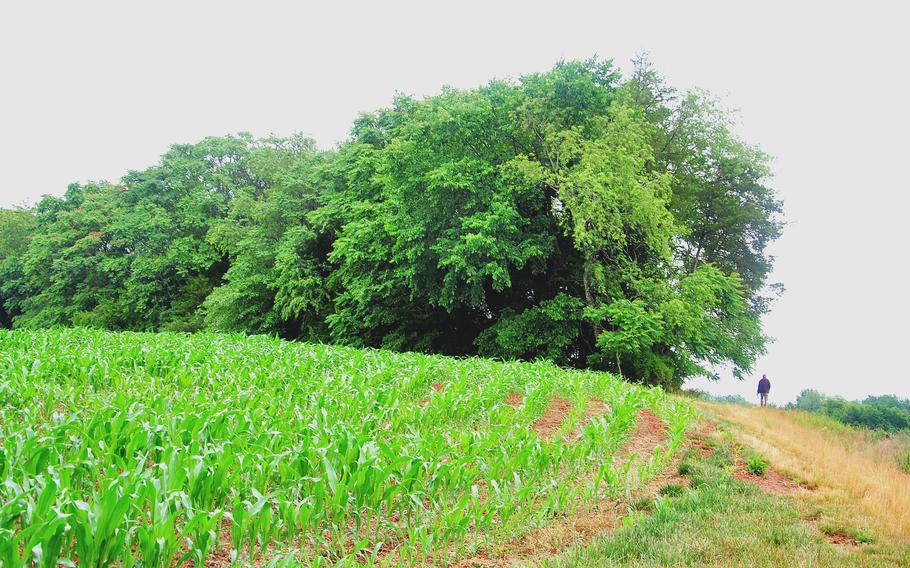
Corn grows in rows where Union soldiers spent the winter of 1863-64 in central Virginia. (Kevin Thomas)
A Union Army tramped past Madden’s Tavern in rural Virginia under clear skies the night of May 3, 1864, on its way to face resilient Confederates waiting below the Rapidan River.
Madden’s Tavern still stands. What was the 1864 property of Willis Madden, a free Black man, and his family, is today a private home and landmark along a gravel road that bears their name, also known as state Route 610.
The army passed that night into a struggle six weeks long, the Overland Campaign, that wrecked what remained of central Virginia after three years of conflict, including Madden’s corn cribs and fruit trees. The armies left abandoned trenches and fresh graves in their wake.
In June, retired Army 1st Sgt. Kevin Thomas and I retraced the route taken by the Army of the Potomac during that campaign. We visited sites associated with the 116th Pennsylvania Volunteer Infantry, a regiment of the Irish Brigade that raised two companies near our hometowns.
Along our way, we found that Civil War battlefields preserve more than the memory of combat, and the sacrifices rendered there. They are also green, open spaces – natural reserves surrounded by rapidly expanding suburbs. Civil War battlefields attract not only historians, amateur and professional, but service members and veterans, day hikers, birdwatchers, runners, bicyclists, walkers, picnickers and lovestruck couples.
Visitors still come to Civil War battlefields to ask why our great-great-grandfathers killed one another there, and whether we can resolve the stubborn differences they left behind.
Our first stop was Stevensburg, Va., a postage-stamp-sized village where state Route 3 meets the York Road. Roadside tablets explain how the village survived the war that nearly obliterated it. But our interest lay in the surrounding fields, where the 116th Pennsylvania made its winter camp along with the First Division of II Corps, Army of the Potomac, in 1863-64.
Lt. Col. Richard Dale, 26, a pious former clerk from the Pittsburgh area, commanded the 116th Pennsylvania in its winter camp while his chief, Col. St. Clair Mulholland, spent the winter recruiting in their home state. Dale left a glimpse of camp life in the regimental journal, daily logging the trials of turning farmers, laborers, shoemakers, blacksmiths and canal boatmen into soldiers.
Dale repeatedly addressed “the general neglect on the part of the men to giving the proper salutes to the officers passing them.” And the camp was filthy, he wrote. The men were “throwing slops between tents.”
Nothing remains of the 116th’s campgrounds but farmers’ fields. On the crests of Hansbrough’s Ridge and Cole’s Hill, adjoining eminences that rise a mile to the east flanking the highway, however, lie the still-blackened hearths of soldier’s huts, row after row of them. It’s the best-preserved site of its kind east of the Mississippi River.
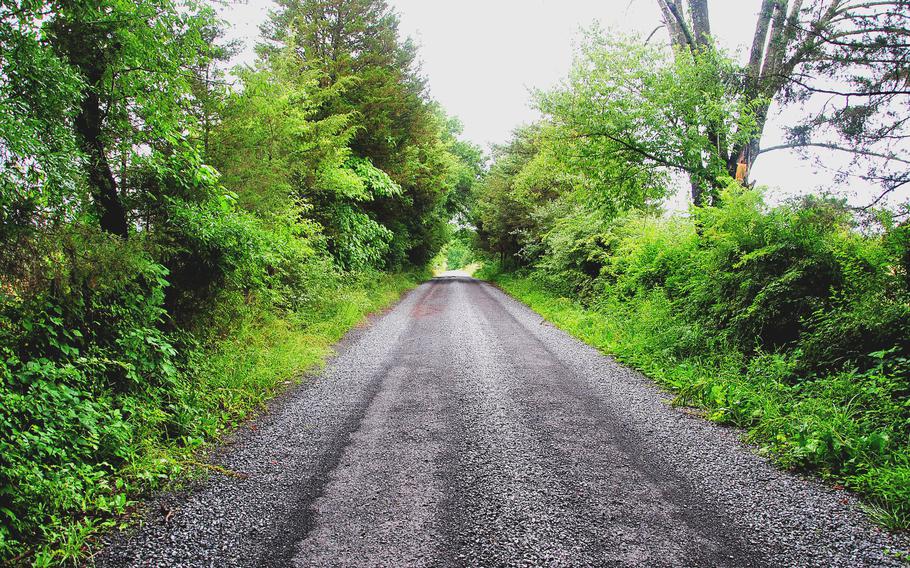
Union troops came this way en route to a showdown with Confederates in Spotsylvania County, Va., in May 1864. (Kevin Thomas)
Into the Wilderness
From Stevensburg, we followed the army’s route to the Rapidan River on May 4, 1864. We drive east on Route 3 to find Madden’s Tavern Road and the former tavern itself.
Summoning dusty columns to fill the road and adjacent fields were light work for our imaginations. The fields along the 15 miles from Madden’s Corner to Ely’s Ford are still fringed by woodlots. Scattered, modest homes line the road next to equestrian estates like Beechwood Farm and Majestic Meadow Stables.
Ely’s Ford at the river looks little like it did in 1864. Tall, modern concrete piers support the highway span high over the river. The forested banks of modern times were cleared back then by browsing livestock and farmers cutting fuel wood. The river we crossed into Spotsylvania County roiled brown and high, swollen by heavy rains flooding central Virginia.
Taken together, the 4,400 acres of Civil War battlefields in Spotsylvania County are the largest public battlefield park in the world. All or part of four major battles were fought here – Fredericksburg, Chancellorsville, the Wilderness and Spotsylvania Courthouse. One campaigning army after another crossed its landscape between 1862 and 1864, meeting in small, forgotten clashes and in titanic struggles.

A monument to New Jersey troops of the Union Army marks where they fought at Mule Shoe on the Spotsylvania Courthouse, Va., battlefield. (Kevin Thomas)
Portions of the battlefields were set aside as national parks in 1927. However, few of the parks’ creators conceived that encroaching development would erase the parts left unprotected, said historian Chris Mackowski, a founder of the Emerging Civil War blog who lives on a portion of the Spotsylvania Courthouse battlefield.
A century after the parks’ creation, toney subdivisions occupy parts of the Wilderness battlefield, and its once sleepy rural roads are now busy commuter and commercial arteries.
“There are many sites that are still at risk, actually, at all those places,” Mackowski said by phone in July. “In some places the preservation movement is fighting a rearguard action, having to play catch-up because real-estate prices in this area, in particular, have skyrocketed over the last 20 or 30 years.”
As development encroaches, the prospect for saving those places loses ground, Mackowski said.
“Well, suddenly it turns into a shopping mall or an industrial complex,” he said. “The commercial value of that real estate is far beyond what the government is able to pay at its assessed value.”
Safe space
We beelined from the river to Saunders Field on the Wilderness battlefield, part of the Fredericksburg and Spotsylvania National Military Park. Here the Union V Corps under Maj. Gen. Gouverneur Warren found the Confederate II Corps on May 5, 1864, and “opened the ball,” in the parlance of the times.
The coronavirus pandemic by September 2020 had dramatically trimmed visitor numbers at the military parks, according to the National Park Service. At a roadside shelter, park service ranger Mary O’Neill said summer tourists were only trickling back into the parks.
Visits to the Virginia battlefields fell 19% in June, 142,738 visits to 176,809 the previous year, according to preliminary park service statistics. The trend deepened through September, when visits were down by nearly 50% from the previous year.
I asked O’Neill whether visitors bring questions about the war’s origins and the legacies of slavery, topics that sometimes surfaced during the previous year’s charged national conversation about social justice and racism.
“All the time,” she said. “Those questions are part of the unfinished conversation about the war and why these sites warrant protection. They are safe spaces for people to have discussions about the meaning of the Civil War.”
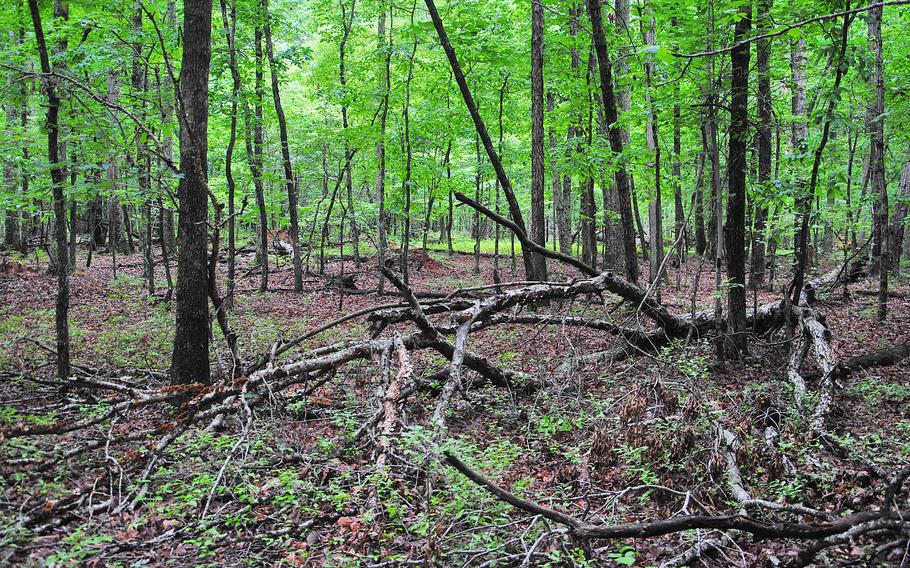
Much of the Wilderness battlefield in Spotsylvania County, Va., looks as it did in May 1864, although the understory is much clearer now than then, based on soldiers’ accounts at the time. (Kevin Thomas)
Brock and Orange Plank
We made our way to the intersection of the Brock and Orange Plank roads, the scene of pitched, close-in fighting on May 5-6, 1864. Commanders on both sides aimed to seize this intersection, knowing that holding it kept their adversaries off their flanks.
II Corps on the north-south Brock Road plunged westward into combat in tangled woods in late afternoon May 5. For thousands of green troops, this was the first test of battle for recruits who drilled for months near Stevensburg.
The forest today is still clotted with second-growth maple, oak and sweet gum, but the understory is mostly clear. The blueberries underfoot, muscadine vines and the occasional spiderweb in our faces suggest the forest our grandfathers muscled through.
We hiked cross-country through a half-mile of swampy woods to a slight rise where we paused to consider the firestorm that preceded us by a century and a half.
Shortly after the fight, Sgt. Samuel Clear of Company K recalled the sounds of faraway volleys crashing through the forest until it seemed roaring waterfalls had erupted behind the curtain of trees just ahead.
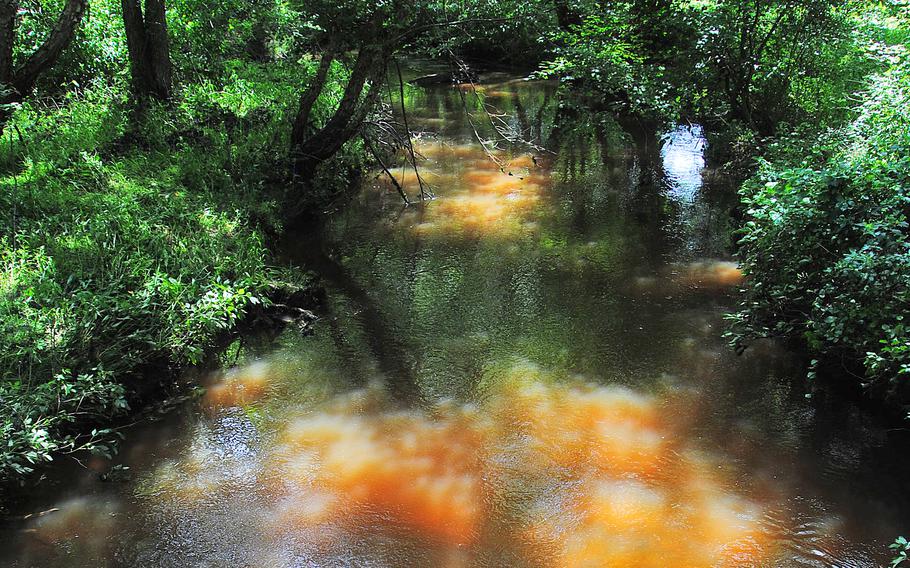
Union soldiers splashed across this portion of Totopotomoy Creek into the teeth of Confederate musket and artillery fire in late May 1864. (Kevin Thomas)
“We pitched into the dark, scrubby pines, grape vines, over old logs, ravines, treetops, and everything that went into making up a wilderness,” his diary recounts. “We just got there in time as the Johnnies was trying to turn our left flank. Fire at will was the command, and we did fire.”
The corps commander, Maj. Gen. Winfield Hancock, recognized the Irish Brigade’s battlefield poise. The brigade, he wrote later, “was heavily engaged, and although four-fifths of its numbers were recruits, it behaved with great steadiness and gallantry, losing largely in killed and wounded.”
‘By the way, we lost’
The next morning, we took up the march route south from Fredericksburg on U.S. Route 1, the Jefferson Davis Highway. It parallels the old Telegraph Road that the Army of the Potomac followed, hustling to beat Robert E. Lee’s army to the next crossroads.
After an hour we arrive at the Shelton House on the Totopotomoy Creek Battlefield Park on state Route 606 in suburban Mechanicsville.
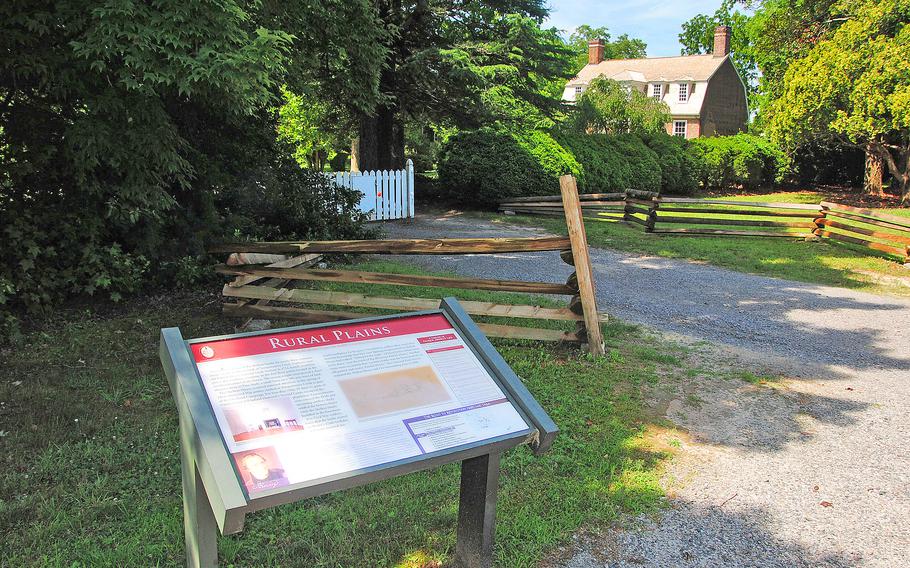
The Union Army occupied the Shelton House, a Confederate plantation home, during the Battle of Totopotomoy Creek in May 1864. (Kevin Thomas)
The historic brick mansion, built in 1723, crowns a hilltop clearing above the creek. On May 30, 1864, the plantation owner, rebel Col. Edwin Shelton, stood on the creek’s south side on a hill opposite his home, asking the Confederate commander there, Maj. Gen. John Breckinridge, to refrain from bombarding the house. Hancock, Breckinridge’s opponent, made his headquarters there, and Union signalmen wagged their flags from its roof.
Breckinridge opened fire and Mrs. Shelton, along with her children and slaves, hid in the basement during the ensuing three-day fight.
Several times, Hancock’s II Corps formed up in fields around the house and charged down the hill, now covered in pokeweed and red maple. The Yankees splashed across the swamp bordering the creek, through the creek itself and up the opposite bluff where the remnant Rebel earthworks still lie quietly, shaded in woods behind a suburban subdivision.
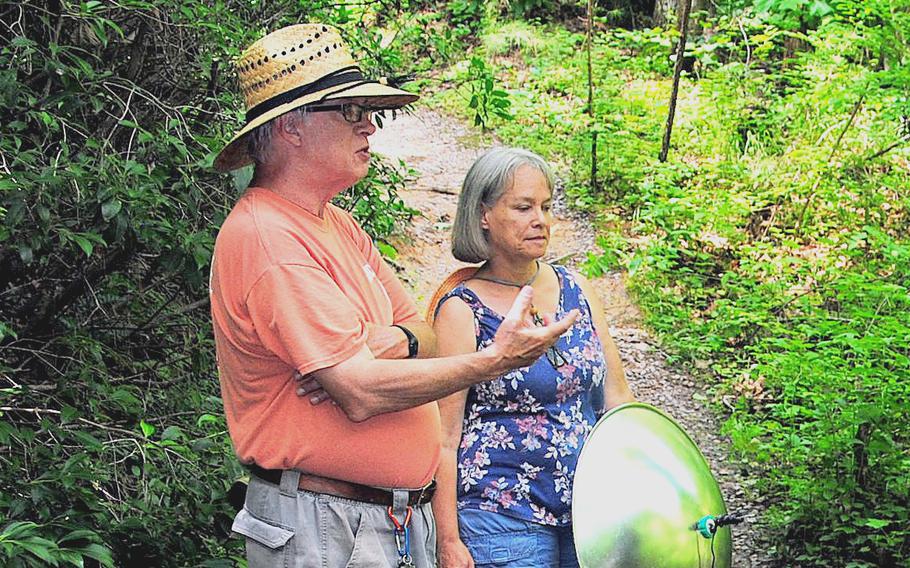
Kent and Connie Durin of Henrico County, Va., employed a dish antenna to record bird calls at Totopotomoy Creek battlefield park, Va., on Sunday, June 13, 2021. (Kevin Thomas)
Beneath the black walnut trees there, we found Kent and Connie Duruin of Henrico County, Va. She carried a parabolic-dish microphone, the kind TV crews carry on football sidelines.
They are naturalists, bird enthusiasts, hunting the calls of oven birds and prothonotary warblers. The two birds’ calls are basically the same, Kent explained, and by recording and replaying them at a slower speed he hopes to find the difference that each species hears that tells one from another.
“If nothing else,” Connie Duruin said, “it’s a walk in the woods.”
For them, the Totopotomoy park is a nature preserve. The past is past, Kent said.
“We’re not worried about ancient history; that war’s over a long time ago, and, by the way, we lost, so,” he said. “Do we preserve the entire state as a battlefield?”
Kent’s father grew up in the middle of a field full of Civil War artifacts, Connie said.
“Cold Harbor,” Kent said. “It was an area that when they were plowing, they would plow up belt buckles and pieces of guns and possibly, occasionally, a skull or something. Down in Hanover. It was one of the most terrible battles ever.”
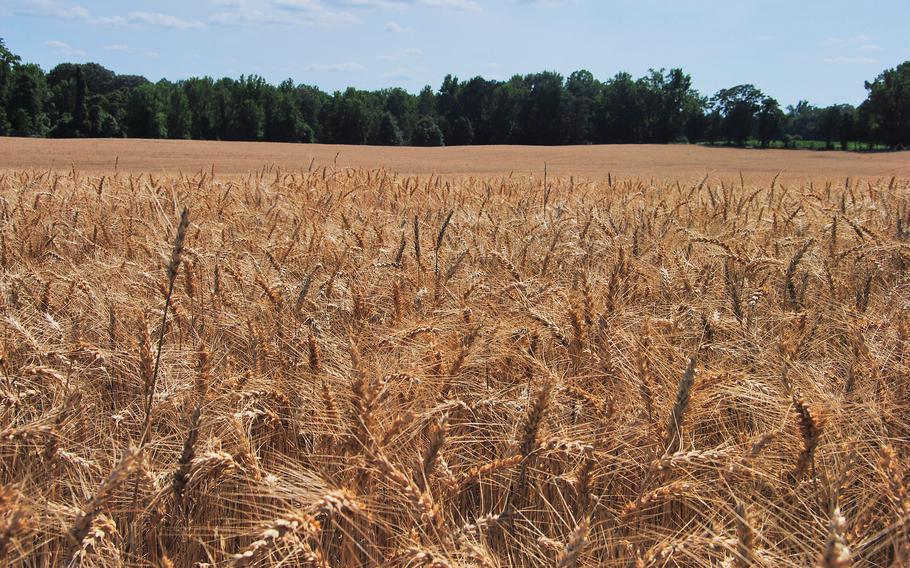
Most of the Cold Harbor battlefield in Virginia, including this section, is in private hands. (Kevin Thomas)
Armies like hornets
The day turned sunny and hot, like the weather the armies endured, when we roll up to the Cold Harbor battlefield. We walk a disorienting, milelong snake of a footpath through the woods and past remnants of the interlocking Confederate earthworks, the Union works opposite them and the one-time killing fields in between.
Coronavirus restrictions put the small visitor center off-limits, but two park service rangers beneath a canopy out front answer questions and retrieve books and other items for sale inside.
We are 10 miles from Richmond, Va., the old Confederate capital and the scene in contemporary times of a fight over monumental statues of Confederate heroes that stood there for a century.
Many were removed in summer 2020, although a year later an equestrian statue of Robert E. Lee still stood on Monument Avenue. In early September, the Virginia Supreme Court ruled for the city and the divisive statue came down Sept. 8.
“I absolutely understand why someone would not want to have that statue and other Confederate statues up, and that’s the kind of stuff our nation has to consider,” ranger Mark Wilcox said.
The battlefield parks themselves memorialize the thousands of soldiers on either side that died there, he said.
“I think a lot of people do consider the battlefields the monuments,” he said, “you can still come to where these things happened, where these battles were fought.”
ditzler.joseph@stripes.com Twitter: @JosephDitzler